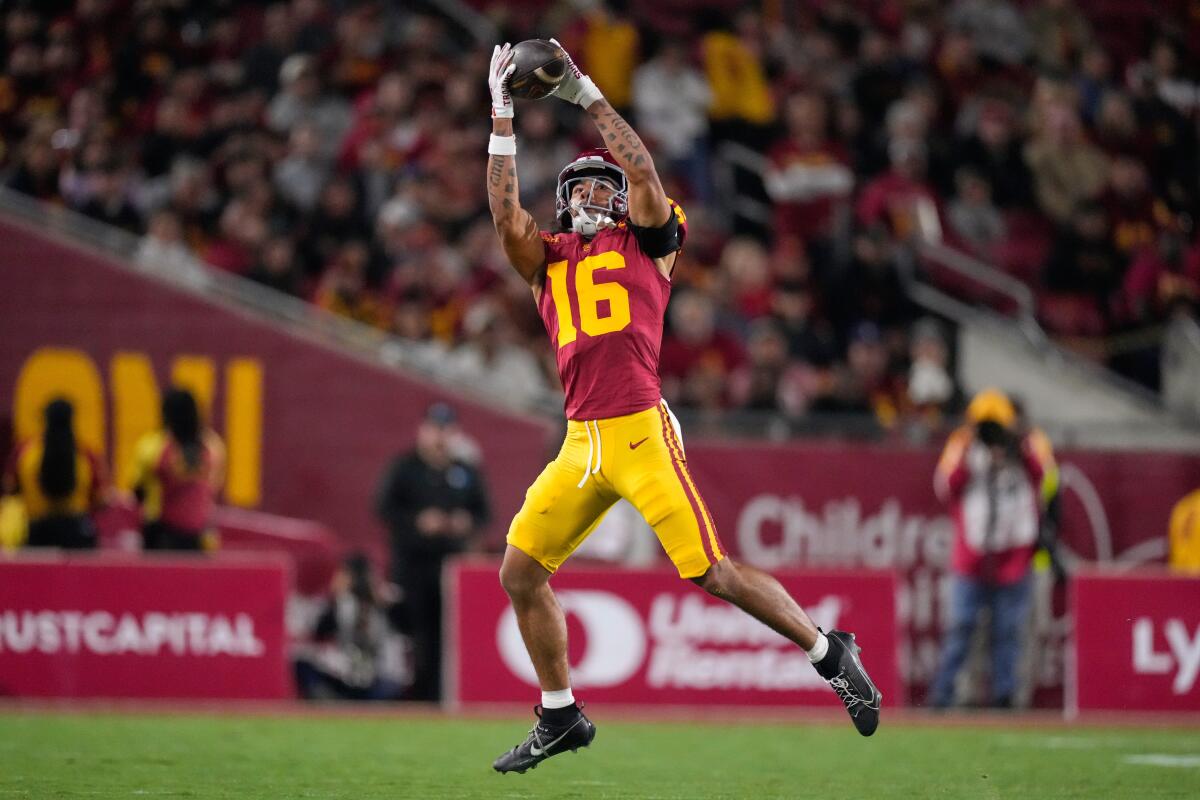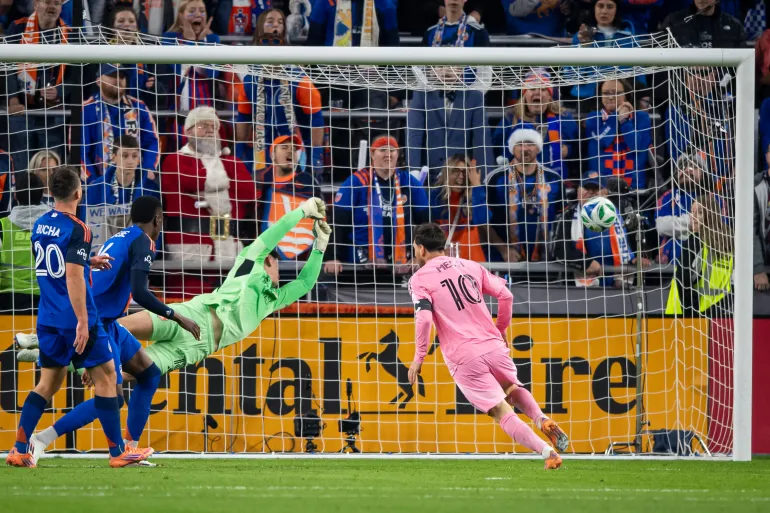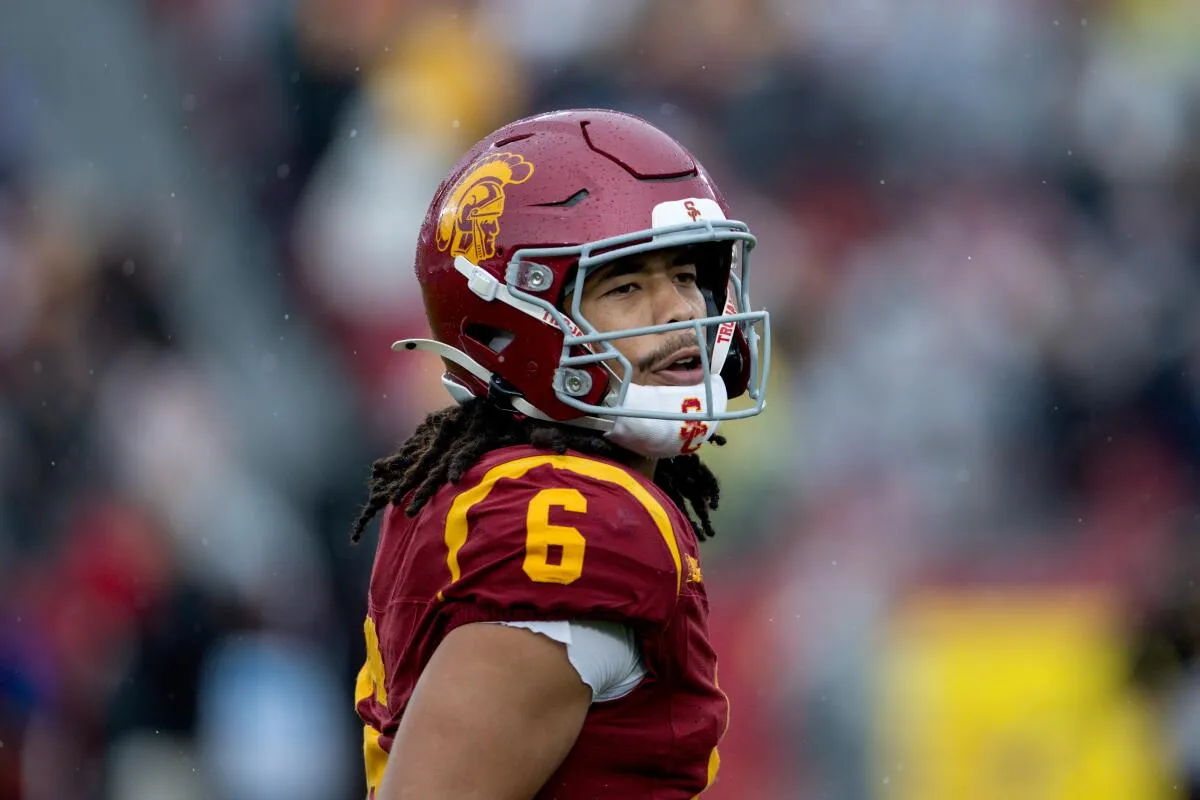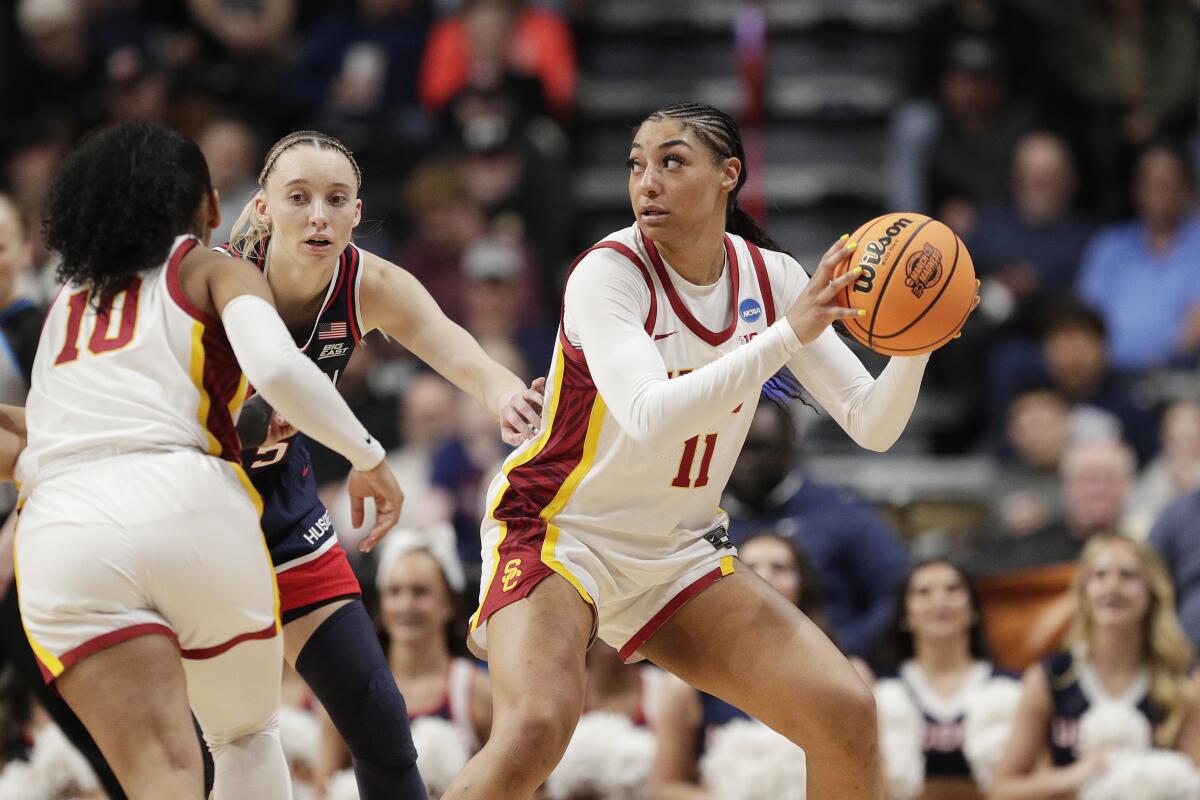Can USC still view this football season as a success?
Welcome back to the Times of Troy newsletter, where USC’s loss to Oregon on Saturday has left me grappling with what it means to have a successful season in this day and age of college football.
USC will not be going to the College Football Playoff. It’ll be the fourth straight year under Lincoln Riley that USC is left out of the field. In that time, Indiana — which last won a conference title in 1967 — will have twice been a Playoff team. Assuming Ohio State, Indiana and Oregon all make this year’s field as expected, the Big Ten’s current membership will have accounted for 19 bids to the Playoff since it began in 2014 … none from USC.
There’s no getting around these facts. USC expects to compete for national titles every year, but in four seasons with Riley as coach, it hasn’t even made it to the dance floor. That’s not what USC was promised when it handed Riley a massive $110-million contract.
If USC beats UCLA next week, as expected, it will finish this season 9-3. That’s better than most rational observers would have expected — myself included. Oddsmakers had USC’s win total set at 7 1/2. I wrote in this space that I thought USC would win eight regular season games, but the best case was 10 and a Playoff bid. USC was within striking distance of that scenario. It fell just short.
Riley would like for you to focus on how narrow that gap is.
“We’re right there,” the coach said again Saturday. But no matter how many plays away USC might be from a Playoff bid in 2025 or four straight national titles in his tenure, Riley’s repeated assurances that this is the case have ceased to mean much to those he thinks he’s assuring. At some point, USC needs to stop being close and actually break through.
It took a step closer to that this season. There’s no shame in losing to three teams ranked in the top 21 of the CFP rankings. USC beat all the teams it was supposed to beat. It won on the road at Nebraska, Riley’s first road win over a .500 team since 2022. And it blew just one fourth-quarter lead, not five like last season.
In the 16 years since Pete Carroll left USC, the Trojans have reached the nine-win mark in the regular season just five times. With a win next week, Riley will have reached that mark twice in four years.
But without a Playoff bid, does a nine-win season really mean anything anymore? Is it possible for USC — or any Power Four team, for that matter — to miss the field and still view its season as a success?
If you thought that USC was going to make the College Football Playoff, you are no doubt disappointed. Most people, though, didn’t. And perhaps the fact that no one is surprised at the way this went is why it’s hard for anyone to feel excited about a 9-3 finish and a second-rate bowl game.
USC took a step forward this season. It wasn’t the leap many fans were hoping for. But it was a step. The reality is this was never a team that was going to seriously compete for a national title. It didn’t have enough talent.
Riley didn’t necessarily do USC any favors in that regard. Progress aside, he simply hasn’t done enough to make anyone, his bosses included, feel good about where next season might go.
There are reasons for optimism. Riley will have the No. 1 recruiting class at his disposal, along with several young returners USC will be counting on to make a leap. But he’ll also have to contend with a schedule that includes Ohio State, Oregon, Washington, Indiana and Penn State.
The road to the Playoff will be as difficult as it has ever been. But that is the bar that Riley must now clear. And by this time next season, we should have a pretty good idea of whether Riley is capable of clearing it.
Going polling
I want to hear what you think about this season as a whole. Do you consider USC’s season to be a success, even without a Playoff bid?
Yes?
No?
Click here to vote in our survey.

Tanook Hines catches a pass thrown by third-string quarterback Sam Huard on a fake punt against Northwestern.
(Mark J. Terrill / Associated Press)
—The leaping penalty was a major turning point in the loss to Oregon. But should it have been a penalty? The flag on linebacker Desman Stephens negated what would’ve been a key missed field goal by Oregon, and afterward, Riley explained that Stephens “panicked” and did something they don’t teach. But NBC rules analyst Terry McAulay, who you may remember from his disdain for USC’s fake punt ploy, posited on social media that it was actually a totally legal play. McAulay wrote that Stephens “leaps into the gap” on the play and “the fact that part of his body is over part of an opponent does not violate the rule,” which states that a player cannot leap into the plane directly above the frame of an opponent. We should note USC lost this game by two touchdowns, so reversing that one wouldn’t have made the difference. That said, I will be curious to ask Riley for his take on Tuesday.
—The offensive line injuries finally caught up to USC. When center Kilian O’Connor went down with what appeared to be another knee injury Saturday and returned to the sideline on crutches, with his leg mobilized, it felt like a foreboding sign. A hobbled J’Onre Reed struggled in his place. Up against a stout Oregon front seven, the Trojans’ line was facing an uphill battle, and it never made much headway. USC ran for just 52 yards, its worst mark in two years. Oregon barely had to blitz — it rushed with four on 27 of 31 dropbacks. This was simply a better defensive line beating up on a more limited offensive line. But USC’s offensive line showed a lot of heart over the course of the last six weeks, and there are plenty of reasons to feel optimistic. USC returns everyone in the room except for Reed and has several freshmen whose progress has impressed the staff this season.
—Tanook Hines can be a star as soon as next season. You saw once again what Hines is capable of as he leaped into the air to reel in Makai Lemon’s pass and tapped his toes in the end zone on the way down. The raw ability is apparent, and his propensity for big plays has been terrific for a freshman. The question now is whether he can emerge as a more consistent threat that’s leaned on to do more than just make highlight catches in traffic. Lemon is leaving for the NFL after this season, and while USC will surely try to convince Ja’Kobi Lane to stay, my guess is he’ll be ready to go, too, depending on his draft grade. That leaves Hines and whichever star transfer wideout(s) general manager Chad Bowden unearths in the portal to lead the receiving corps. Hines should be a big part of those plans, no matter what, and if he makes the leap, he could be in for a huge sophomore season.
—USC won’t be going to the Playoff, but there will be a consolation bowl appearance. Assuming the Trojans can win next week against UCLA, they’re most likely headed to the Alamo Bowl in San Antonio on Dec. 30. The Holiday Bowl on Jan. 2 is also in play. USC has played in the Holiday Bowl four times in the last 12 years. It has never appeared in the Alamo Bowl.
—After a brutal loss to Notre Dame, USC women’s basketball faces a critical stretch ahead. The Trojans had a chance to win in South Bend with a layup after a frustrating fourth quarter, but missed it, and Hannah Hidalgo ended the game on the other end. They have four games between now and a Dec. 13 matchup with Connecticut at Galen Center, and they’ll need that time to iron things out. Kennedy Smith needs to be more consistent on offense, and the frontcourt remains a mystery. The next two weeks should help answer some pertinent questions.
Olympic sports spotlight
With two games left in its regular season slate, USC’s women’s volleyball team matched its season-high for wins under coach Brad Keller with its 24th victory on Saturday. It should surpass that mark this week.
It’s been a stellar season so far for the Trojans, who are tied for fourth in the Big Ten. The question now is just how far they can go in the postseason. Right now, according to ESPN’s college volleyball bracketology, USC is predicted to be a fourth seed.
In case you missed it
Plaschke: Lincoln Riley should be on hot seat after USC flops again in big game
No. 15 USC’s College Football Playoff hopes shattered in loss to No. 7 Oregon
No. 11 USC can’t protect double-digit lead in road loss to No. 24 Notre Dame
USC vs. Oregon: Lincoln Riley embraces pressure of playing for a playoff bid
How USC’s transfer portal approach has fueled its push to edge of playoff berth
Hot coaching commodity Lane Kiffin has a tough decision 12 years after USC fired him
What I’m watching this week

Will (Noah Schnapp) and Vecna (Jamie Campbell Bower) come face to face in Season 5 of “Stranger Things.”
(Netflix)
We’ve waited over three years, if you can believe it, for a new season of “Stranger Things.” So long that none of the kids in the show are even kids anymore. (Two of them have actually become rock stars in the meantime.)
But I’m one of those who have been eagerly awaiting the series conclusion, and finally, that day has come. We still only get Volume 1 from Netflix on Wednesday. But that should be enough to hold us off until late December, when the remaining episodes drop.
Until next time …
That concludes today’s newsletter. If you have any feedback, ideas for improvement or things you’d like to see, email me at [email protected], and follow me on X at @Ryan_Kartje. To get this newsletter in your inbox, click here.





